7 Brilliant DIY Ideas For Nail Polish Removers
Ways to keep your nails clean and healthy with easily available home ingredients.
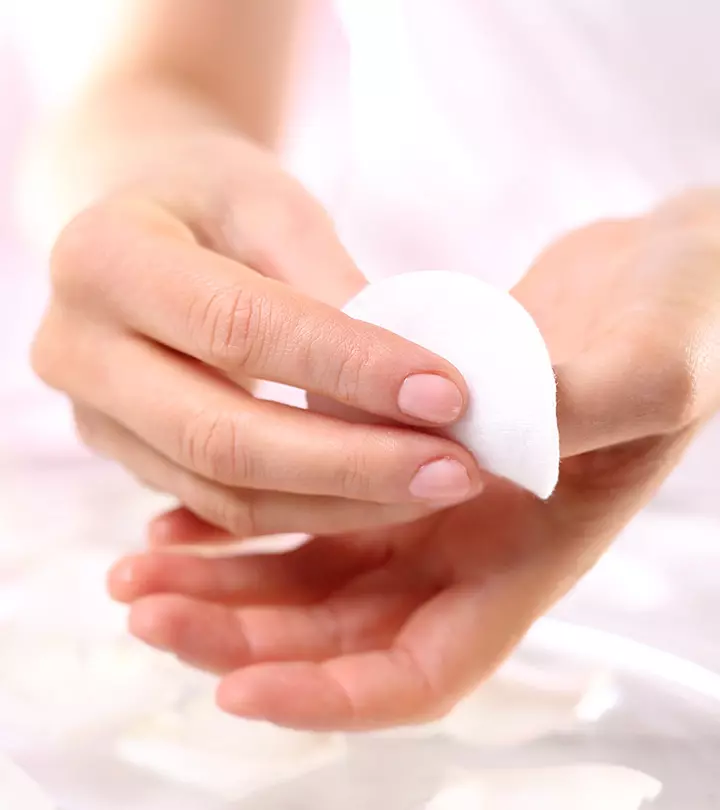
Image: Shutterstock
DIY ideas for nail polish removers can save you on an unfortunate day! How?
Imagine you are all set to go to a party, trying to find your shoes, when suddenly your eyes notice your fingernails with chipped nail polish! Only you do not have to imagine because this happens to us all. And interestingly, these are often the moments when you realize that you have run out of nail polish removers. But do not get impatient or panicky because we are here to help.
The easy-to-use homemade nail polish removers have simple, non-toxic recipes and are healthier, safer, and cheaper than the regular ones. So, swipe up to explore them!
 Keep In Mind
Keep In Mind- Application: Application Use a cotton ball or Q-tips for removing nail polish.
- Aftercare: Application Thoroughly wash your hands after using nail polish removers as they often contain harsh ingredients.
- Prevent Allergic Reactions: Application Avoid using ingredients such as vinegar, lemon, aerosol spray and rubbing alcohol on sensitive skin.
- Caution: Application Refrain from using any type of remover in case of open wounds or cuts.
In This Article
What Does Nail Polish Remover Contain?
The main ingredient in most nail polish removers is acetone, which is a strong solvent that can dissolve nail polish (1). Other common ingredients in nail polish removers include ethyl acetate and isopropyl alcohol (1). These ingredients help to improve the solubility of the nail polish in the acetone and make the nail polish easier to remove.
If you want to make your own DIY nail polish remover, you can use acetone as the main ingredient. However, it is important to note that acetone can be very strong and drying for the skin. So you should use it with caution and avoid getting it on your skin.
Other ingredients you can use to make DIY nail polish remover include rubbing alcohol, vinegar, and lemon juice. Keep reading to find out how to use these ingredients to create your own at-home nail polish remover!
Key Takeaways
- Try a vinegar and lemon juice mixture to remove your nail paint naturally.
- Your deodorant can be a great option for removing your nail polish.
- Grab your hand sanitizer and use it as a nail remover.
- Try applying a fresh layer of any nail polish, and while it is wet, remove it with a cotton ball.
How To Make Nail Polish Remover At Home
A DIY nail polish remover can save you a lot of time and trouble! These methods make use of accessible ingredients that are often found in your kitchen. This makes them economical and eco-friendly alternatives to traditional removers. Here are seven amazing DIY homemade acetone-free nail polish removers.
1. Lemon
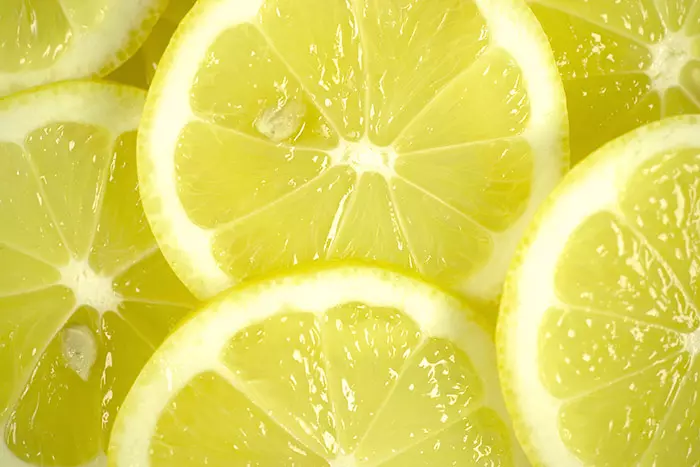
Lemon is a natural ingredient that can be used to remove nail polish. It is a natural ingredient used in manicures and pedicures. It is also how you can get nail glue off skin when your mani-pedi gets messy. All you have to do is rub a slice of lemon on your nails and remove the nail polish. Now, isn’t that easy?
You Will Need
- Lukewarm soap water
- A slice of lemon
- Cuticle oil or moisturizer
How To Remove Nail Polish With Lemon
- Soak your fingers with nail polish in lukewarm soapy water for about 3-5 minutes.
- Then, use a lemon slice as an alternative to commercial nail polish remover. This will help soften the nail polish so that it comes off easily.
- Use a moisturizer or nail oil to maintain your nail health after that.
Let us now take a quick look at the pros and cons of using lemon for cleaning up nail polish.
Pros
Here’s a short list of pros for using lemon to remove nail polish.
- Natural and gentle – Lemon is a natural ingredient that may be less harsh on nails and skin than chemical removers.
- Readily available and cost-effective – Lemons are commonly found in most homes and are a cost-effective alternative to commercial nail polish removers, making this an easy DIY solution.
- Multipurpose – In addition to removing nail polish, lemon may also help get rid of nail glue residue on skin.
Cons
Here are some potential drawbacks or safety considerations for using lemon as a DIY nail polish remover.
- Ineffective on dark or gel polish – Lemon may not be strong enough to remove dark, glitter, or gel-based nail polishes. Prolonged exposure to lemon juice may cause temporary yellowing of nails, especially if they are already weak.
- Time-consuming process – Unlike acetone-based removers, using lemon requires soaking and scrubbing, making it a slower alternative.
- Not suitable for frequent use – Regular use of acidic ingredients like lemon can weaken nails over time, making them more prone to splitting.
2. Vinegar
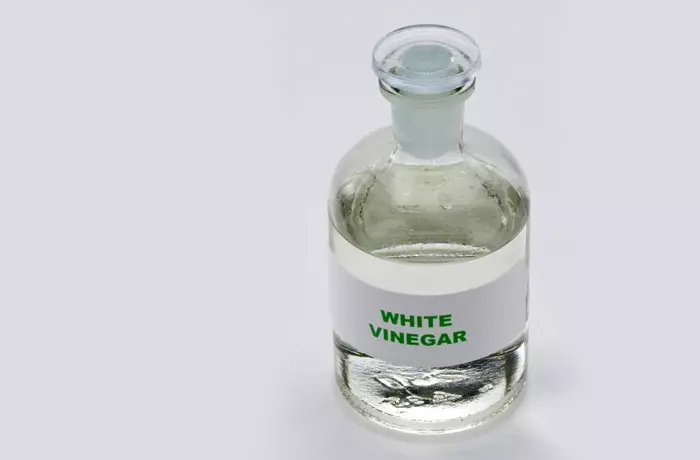
Vinegar is an acidic ingredient that can break down nail polish. Vinegar is also something that can often be found in homes or your local supermarkets.
You Will Need
- Cotton ball
- Vinegar
- Lemon Juice
How To Remove Nail Polish With Vinegar
- Soaking the nails in warm water for 10-15 minutes before removing the nail polish can help to speed up the process.
- Mix equal parts of lemon juice and vinegar.
- Stir the mixture, soak a cotton ball in it, press it onto your fingernails, and hold it for 10-20 seconds. This causes the nail enamel to dissolve and removes all the remnants of nail polish.
- Then use the cotton ball to wipe the polish off. It might take a little longer to remove the nail paint if there are several coats.
- Don’t forget to moisturize or apply nail oil afterwards.
Here are some pros and cons of using vinegar to remove nail polish.
Pros
Here’s a short list of pros for using vinegar to remove nail polish.
- Easily accessible – Vinegar is a common household item that can be found in most kitchens.
- Cost-effective – It’s an affordable alternative to more expensive nail polish removers.
- Gentle on skin – When mixed with lemon juice, vinegar offers a milder formula compared to acetone-based removers.
Cons
Let us now read about the drawbacks of using vinegar to remove polish.
- Can weaken nails over time – Frequent use of acidic solutions like vinegar may contribute to nail thinning and increased brittleness.
- Might cause mild irritation – Those with sensitive skin or small cuts may experience a slight burning sensation. The smell might also linger.
- Requires patience and effort – Unlike commercial removers, vinegar takes longer to dissolve nail polish and may require multiple applications.
- Possible residue left behind – Some nail polishes may not come off entirely, necessitating extra scrubbing or additional soaking.
 Quick Tip
Quick Tip3. Alcohol

Rubbing alcohol is a good alternative to thin out nail polish for those who don’t have lemon juice and vinegar to prepare a homemade nail paint remover. It is more natural and less harsh than the chemicals found in commercial removers. An alcohol solution can be used to remove buildup of lacquer on the nails (2).
You Will Need
- Rubbing alcohol
- Bowl of lukewarm water
- Cotton ball
How To Remove Nail Polish With Alcohol
- Soak your nails for some time in the bowl of lukewarm water.
- Wet a cotton ball with alcohol and use it to wipe off the nail paint.
- To keep your nails healthy, use a moisturizer and cuticle oil.
Take a look at some of the pros and cons of using alcohol for removing nail polish.
Pros
Here’s a short list of pros for using rubbing alcohol to remove nail polish:
- Natural alternative – Rubbing alcohol is a more natural option compared to many commercial removers.
- Antibacterial properties – It can help reduce the risk of infections, making it a good choice for nail care.
- Gentler on skin – Rubbing alcohol, less harsh than acetone, is a comforting choice for those with sensitive skin, ensuring a gentle nail care routine.
- Affordable – Rubbing alcohol is an inexpensive household item that can be used in a variety of ways, including nail polish removal.
Cons
Here are some drawbacks of using alcohol for removing nail polish
- Strong scent – The sharp smell of rubbing alcohol can be unpleasant and may linger on the skin.
- Requires soaking for best results – Unlike commercial removers, alcohol works more effectively after nails have been soaked in warm water, making the process longer.
- Not as fast-acting as acetone – Alcohol takes longer to break down nail polish, making it a less convenient option for quick polish removal. Those with delicate skin or existing nail issues might experience redness or discomfort after use.
4. Deodorant
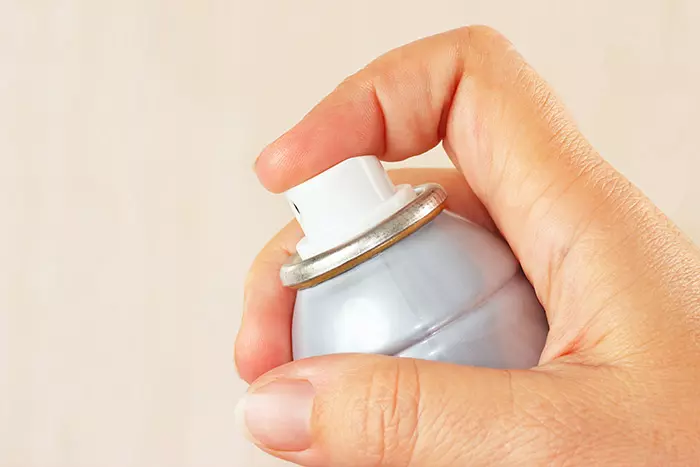
Are you running out of all the above supplies? Acetone is the main ingredient present in store bought nail polish removers, but it can be harsh on the skin. Don’t worry! Deodorants also contain some solvents that can act as wonderful nail polish removers.
You Will Need
- Deodorant spray
- Cotton ball
How To Remove Nail Polish With Deodorant
- Before doing this, make sure you are not allergic to spray deodorants.
- Just grab your deodorant can and keeping the nozzle at a closer range, spray it over your nails.
- Immediately wipe it off using a cotton ball. Deodorants have alcohol and acetone in them that will help to clean the nails and remove the nail paint quickly.
Let us now check out the pros and cons of using deodorants to remove nail polish.
Pros
Here’s a short list of pros for using deodorant to remove nail polish:
- Common household item – Most people already have deodorant at home, making it a convenient alternative.
- Works on multiple layers – The alcohol and acetone in deodorants can effectively break down thicker nail polishes.
- Multipurpose product – It serves as a deodorant and a nail polish remover, making it versatile.
Cons
Here are some things that you need to keep in mind before using it on your nails.
- Strong fragrance – The overpowering scent of deodorant may linger on your hands.
- Potential allergic reactions – Some people may be allergic to ingredients in deodorants, so a patch test is necessary before use.
- Can be wasteful – Using deodorant as a nail polish remover requires multiple sprays, which can deplete your product quickly.
- May leave a sticky residue – Some deodorant formulas contain conditioning agents that can leave a film on the nails, requiring additional cleaning.
- Not cost-effective – Regular use of deodorant for nail polish removal can be more expensive than buying an actual nail polish remover.
5. Hand Sanitizer
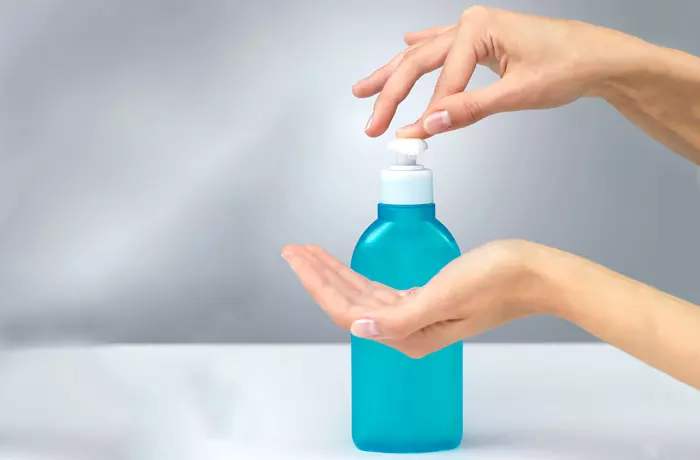
Another DIY hack for removing nail polish from your nails is by using a hand sanitizer! This is something that can be easily found around the home so try it out!
You Will Need
- Hand sanitizer
- Cotton ball
How To Remove Nail Polish With Sanitizer
- Squirt a little of the hand sanitizer on your nails. Immediately rub a cotton ball over them.
- Repeat the process until the polish starts to come off. However, don’t use a lot of sanitizer.
- Be sure to wash your hands thoroughly once you are done with it. Otherwise, it will dry on your nails. Now that’s something you don’t want, do you?
Let us now take a look at some pros and cons of using hand sanitizer to remove nail polish.
Pros
Here’s a short list of pros for using hand sanitizer to remove nail polish:
- Easily accessible – Hand sanitizer is commonly found at home, making it a convenient option.
- Multipurpose product – You can use it to sanitize your hands and remove nail polish.
- Non-toxic alternative – It’s a gentler option than harsh chemicals like acetone, though it still works effectively.
Cons
Check out these points to make sure you use it correctly.
- Can be extremely drying – Hand sanitizer can be extremely drying. The high alcohol content can strip natural oils from nails and cuticles, leading to dryness and brittleness.
- Strong smell – Some sanitizers have a strong fragrance or medicinal scent that may linger on the hands.
- Repeated application needed – Unlike acetone, sanitizer does not dissolve nail polish quickly, requiring multiple attempts to remove it fully.
- Risk of overuse – Using too much sanitizer may cause nails to become weak and prone to splitting over time.
- Not as fast-acting as commercial removers – The process takes longer compared to acetone-based removers, making it less convenient.
6. Nail Polish
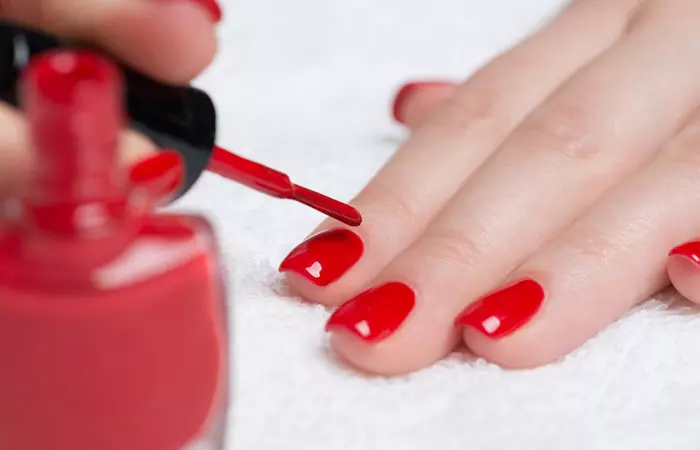
Okay, I know how this sounds. Nail polish to remove nail polish? Trust me, it actually works! Nail polish dries due to the evaporation of solvents. These solvents also soften the polish, so applying nail polish on nail polish makes it easy to remove it! Fight fire with fire, right?
You Will Need
- Any old nail polish that you don’t mind wasting.
- Kitchen paper towel
How To Remove Nail Polish With Nail Polish
- Apply the nail polish on your nails. Make sure it’s not a fast drying one.
- Use a paper towel immediately to wipe it off.
- It may take a few tries to clean it away completely.
Let us now look at some pros and cons of using nail polish for removing nail polish.
Pros
Here’s a short list of pros for this method.
- Quick and simple – The process is easy to execute with minimal steps.
- No harsh chemicals – It’s a gentler method compared to some commercial removers, making it ideal for sensitive skin.
- Convenient for emergencies – If you run out of remover, this can be a quick fix using materials you already have.
- No need for soaking – Unlike other methods, this one doesn’t require soaking your nails, making it faster.
Let us look at some drawbacks of this method to ensure you use it correctly.
Cons
- Can be messy – Since the polish doesn’t dry immediately, it can smear on the skin or surrounding areas, making cleanup more difficult.
- Can be wasteful – Since this method requires sacrificing a bottle of nail polish, it may not be the most cost-effective solution.
- Risk of staining nails – Some dark or heavily pigmented polishes may leave a tint on the nails, requiring additional cleaning.
7. Hydrogen Peroxide
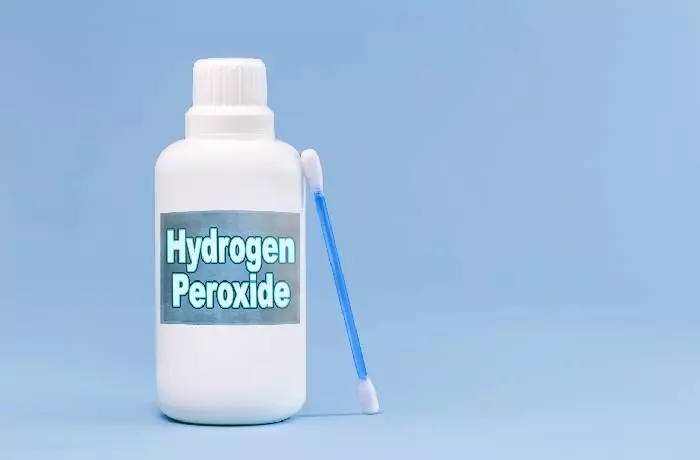
Hydrogen peroxide is a widely used cosmetic product that can help to soften the nail polish and make it easier for it to come off.
You Will Need
- Hydrogen peroxide
- A bowl of hot water
- Cotton balls or earbuds
How To Remove Nail Polish With Hydrogen Peroxide
1. Mix 3% hydrogen peroxide in a bowl of warm water. And immerse the cotton balls in it.
2. Apply these soaked cotton balls to your nails and wait for a few minutes.
3. Gently rub the cotton to soften the nail polish.
4. Repeat the same process if some nail polish remains.
5. Rinse your hands with water thoroughly to get rid of hydrogen peroxide.
6. Follow it up with a moisturizer or cuticle oil.
Now that you know how to use hydrogen peroxide to remove nail polish, let’s examine the pros and cons of this method.
Pros
Here are some pros of using hydrogen peroxide to remove nail polish.
- Easily accessible – Hydrogen peroxide is a common household product and can be found easily.
- Affordable option – It’s a cost-effective alternative to commercial nail polish removers.
- Moisturizing potential – When followed by a moisturizer or cuticle oil, it helps keep nails hydrated.
- Safe for sensitive skin – It’s generally less irritating than some chemical-based removers when used in moderation.
Cons
Check out some common drawbacks of using this method to ensure you are prepared for the shortcomings.
- Potential skin irritation – Some people may experience mild burning, redness, or sensitivity, especially if they have cuts or sensitive skin.
- Strong chemical smell – Hydrogen peroxide has a noticeable odor that some may find unpleasant.
- Risk of nail discoloration – Frequent use of hydrogen peroxide can sometimes leave nails looking slightly white or faded. Regular exposure to hydrogen peroxide may weaken nails over time, making them more prone to damage.
- Requires careful handling. Using too high a concentration or not rinsing properly can lead to irritation or overdrying of the skin.
Tips And Precautions To Be Followed While Using DIY Nail Polish Removers
- These methods are only alternatives that are affordable too. They might not be as effective as nail polish removers since the key ingredient to removing nail polish is acetone, which is absent in them.
- When using nail polish to remove nail polish, make sure that what you’re using does not dry quickly. It’s best to wipe it off while it’s still wet. If it dries, it may be even more difficult to remove.
- If you are allergic to any of these ingredients, it is best to avoid them. Always perform a patch test before dipping all your nails in an unfamiliar ingredient.
- Don’t forget to moisturize and apply cuticle oil once you have removed the nail polish. This keeps your nails healthy.
 Quick Tip
Quick TipAfter removing your nail polish, you must give your nails the care they deserve to look healthy. Here is how to go about it.
How To Care For Your Nails Post-Removal?
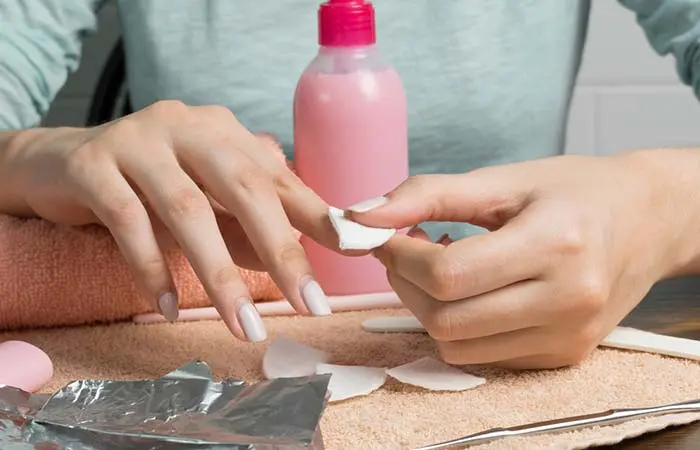
After removing nail polish it is very important to give your nails some extra care to keep them healthy and strong.
- Wash your hands thoroughly to remove any leftover polish remover.
- Apply a moisturizing cuticle oil or hand cream to nourish both the nails and the surrounding skin.
- Buff your nails gently to smooth any rough edges and improve circulation.
If your nails appear weak or brittle, you can apply a strengthening treatment or nail hardener to restore their health. Taking a short break from nail polish also allows your nails to breathe and recover from any potential damage.
Infographic: 6 Alternative Ingredients To Substitute Nail Polish Remover In An Emergency
You need to be ready within the hour and realize that your nails are messily speckled with your old polish. But you forgot to order a bottle of nail polish remover! You need a cheat sheet of substitute nail care ingredients to use in place of a remover. And the best part, you are most likely to have these ingredients around the house.
Here’s the infographic with the list of common household items that can help you get rid of nail polish quick and easy. Illustration: StyleCraze Design Team
Bet you would never have imagined these DIY ideas for nail polish removers. They are conveniently available household items that could save the day. Cool! Right? The next time you run out of nail polish remover, you know what to do! Make a note of these brilliant DIY ideas for nail polish remover, and you will have your alternative eco-friendly backup options handy. If you have not tried these yet, are you waiting for the next crisis? Go on, test them all out and prepare to be impressed! You can thank us by sharing these tips with your friends.
Frequently Asked Questions
Can you use toothpaste to remove nail polish?
Yes, you can use toothpaste to remove nail polish. Just scrub your nails with regular toothpaste or one that contains baking soda.
Can you use tissues to remove nail polish?
Using tissues to remove nail polish is not wise as they shred. The process can be a hassle. A washcloth can be a good alternative.
Does coconut oil remove nail polish?
No, coconut oil can’t remove nail polish from your nails, but it may remove nail paint from the skin.
How can I remove my nails at home with water?
Soak them in lukewarm, soapy water for a few minutes. This softens the nail polish. Then, gently scrape the nail polish off with the help of a cuticle stick.
How do salons remove gel polish?
Salons typically use acetone nail polish remover to remove gel polish.
What is the safest nail polish remover?
Acetone-free nail polish removers or any nail polish remover made of natural ingredients is safe.
Does salt remove nail polish?
No, salt can’t remove nail polish.
Can dish soap remove nail polish?
No, but it may work to remove nail polish stains from clothes.
Which fruit can remove nail polish?
Lemon, with its acidic properties, can remove nail polish.
Check this helpful tutorial, and discover 10 ingenious methods to effortlessly remove nail polish, whether you have a remover on hand or not. Say goodbye to stubborn polish with ease!
References
Articles on StyleCraze are backed by verified information from peer-reviewed and academic research papers, reputed organizations, research institutions, and medical associations to ensure accuracy and relevance. Read our editorial policy to learn more.
- Acetone
https://pubchem.ncbi.nlm.nih.gov/compound/Acetone - Topical and device‐based treatments for fungal infections of the toenails
https://pmc.ncbi.nlm.nih.gov/articles/PMC6984586/
Read full bio of Simone de Vlaming
Read full bio of Ramya Karamsetti
Read full bio of Shatabdi Bhattacharya
Read full bio of Joyce Joyson








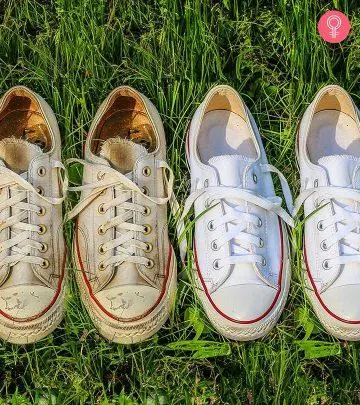

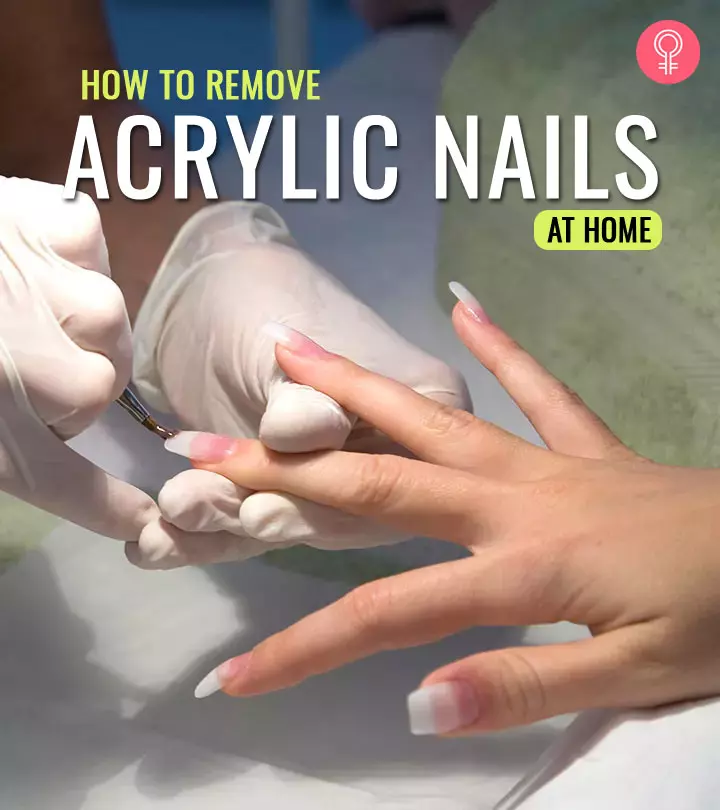
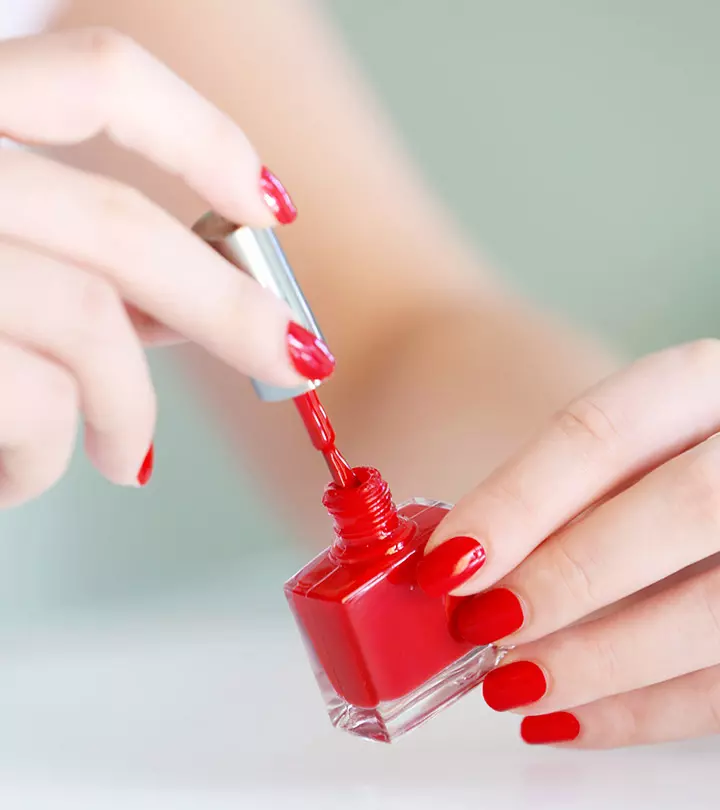

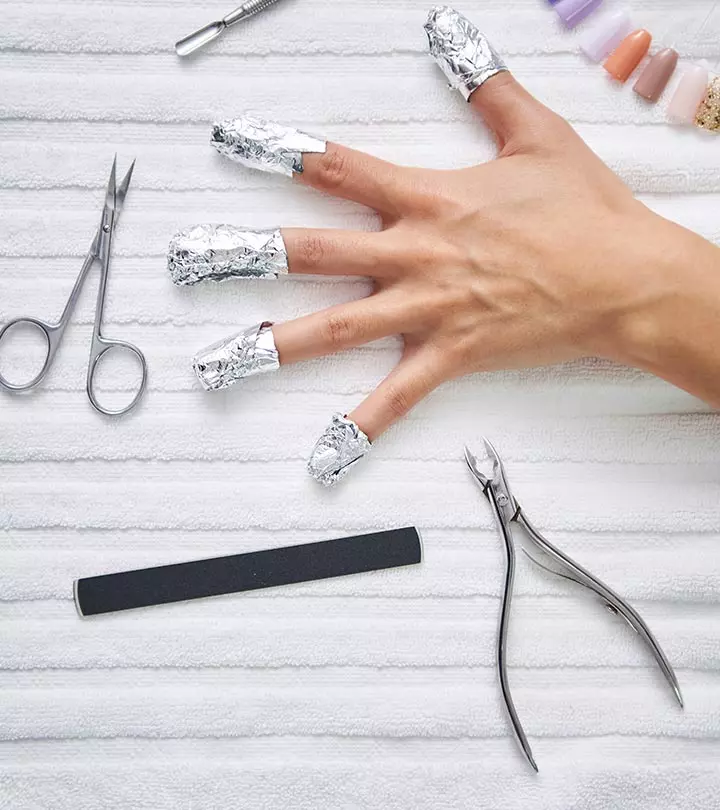
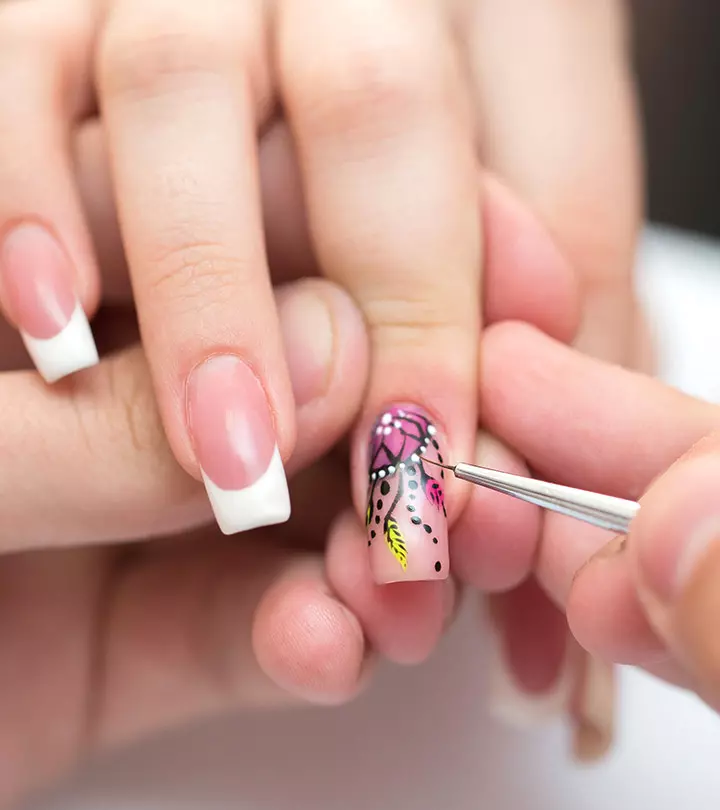




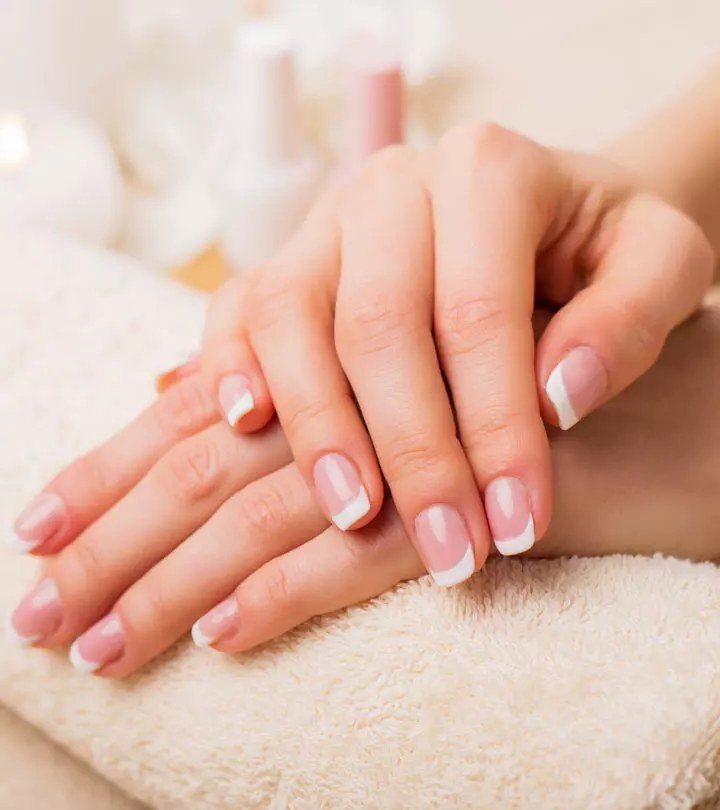

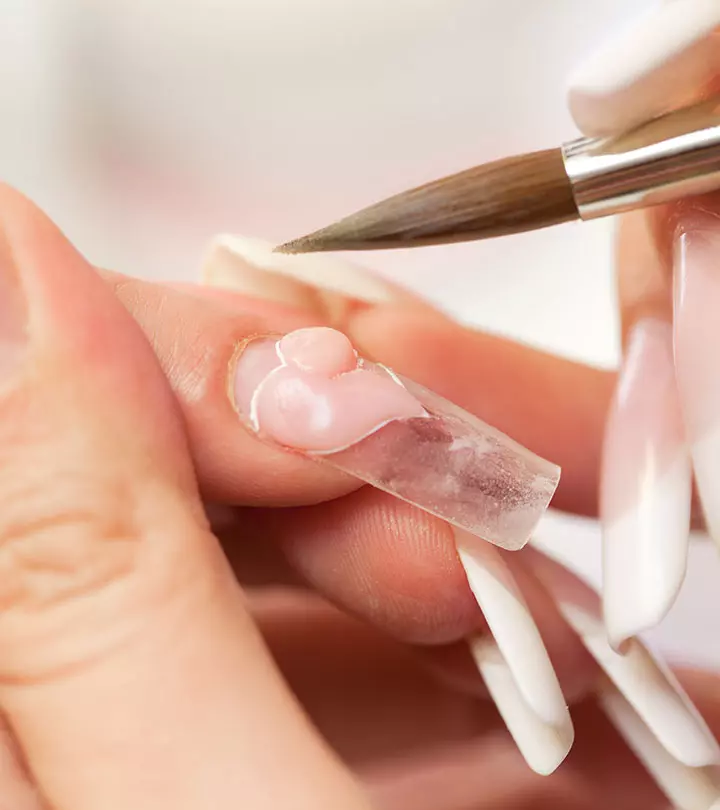
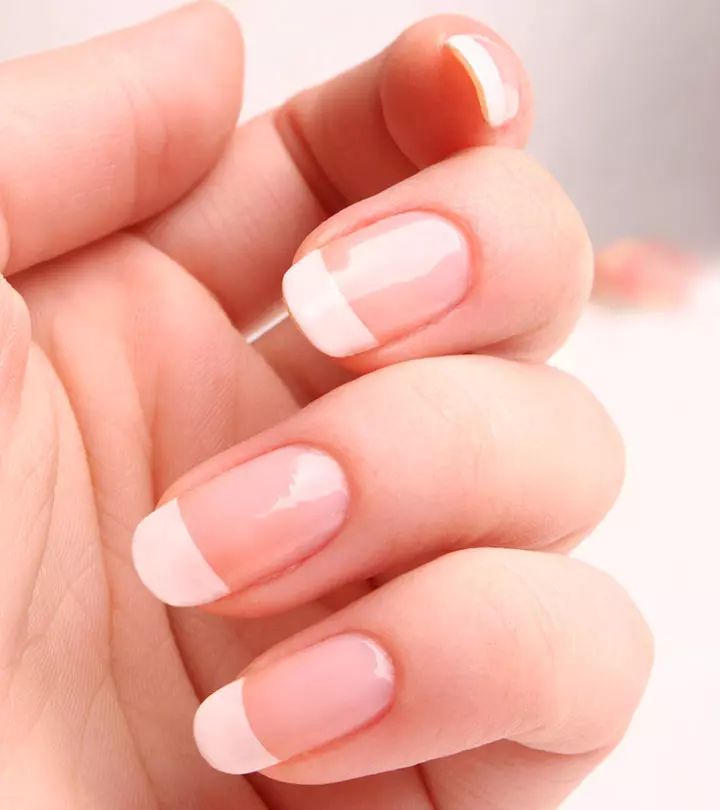
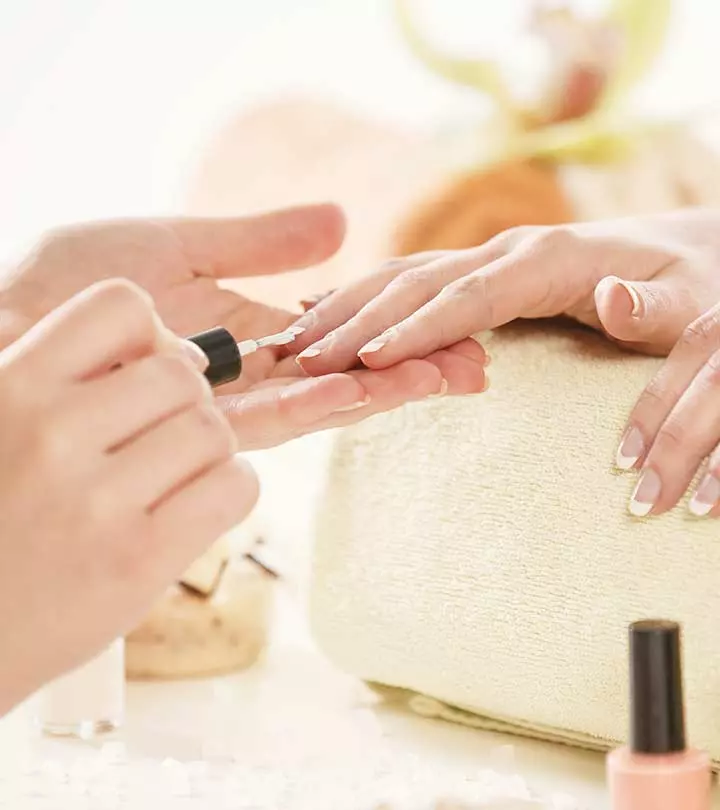

Community Experiences
Join the conversation and become a part of our empowering community! Share your stories, experiences, and insights to connect with other beauty, lifestyle, and health enthusiasts.